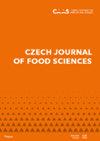肉质。遗传背景及其分析方法
IF 1
4区 农林科学
Q4 FOOD SCIENCE & TECHNOLOGY
引用次数: 2
摘要
消费者意识的增强正迫使食品生产商提供越来越高质量和促进健康特性的原材料和产品。了解品质特征的遗传背景是非常重要的,这使得基于分子标记的选择成为可能。分子技术产量的不断增加,加上生物信息学基础设施的不断扩大,使人们对影响肉质的分子机制的理解不断提高。这导致了多态性核苷酸的鉴定[单核苷酸多态性(snp)]显示了与肉类特征的关系,如嫩度[钙蛋白酶(CAPN)和钙pastatin (CAST)基因多态性],大理石纹[二酰基甘油o-酰基转移酶1 (DGAT1)],颜色,pH值和保水能力(WHC) [CAST,硬脂酰辅酶a去饱和酶(SCD)和其他],以及脂肪酸谱(SCD1)。越来越多的方法被用于分析,从基于核酸扩增的技术[聚合酶链反应-限制性片段长度多态性(PCR-RFLP)和扩增难解突变系统- pcr (ARMS-PCR)]通过Sanger测序到高通量下一代测序(NGS)技术。本文综述了决定肉类品质性状的基因多态性及其分子检测方法的研究进展。本文章由计算机程序翻译,如有差异,请以英文原文为准。
Meat quality – Genetic background and methods of its analysis
Growing consumer awareness is forcing food producers to supply raw material and products of increasingly high quality and health-promoting properties. Knowledge of the genetic background of quality characteristics is taking on great importance, enabling selection based on molecular markers. The increasing throughput of molecular techniques, in combination with an expanding bioinformatics infrastructure, is leading to continual improvement in understanding of the molecular mechanisms influencing meat quality. This has resulted in the identification of polymorphic nucleotides [single nucleotide polymorphisms (SNPs)] showing a relationship with meat characteristics such as tenderness [polymorphism in the calpain (CAPN) and calpastatin (CAST) genes], marbling [diacylglycerol o-acyltransferase 1 (DGAT1)], colour, pH and water-holding capacity (WHC) [CAST, stearoyl-CoA desaturase (SCD) and others], and fatty acid profile (SCD1). An increasingly wide range of methods is used for analysis, from techniques based on amplification of nucleic acids [polymerase chain reaction-restriction fragment length polymorphism (PCR-RFLP) and amplification refractory mutation system-PCR (ARMS-PCR)] through Sanger sequencing to high-throughput next-generation sequencing (NGS) techniques. This paper is a review of the literature on polymorphism of genes determining the quality characteristics of meat and molecular methods used to detect them.
求助全文
通过发布文献求助,成功后即可免费获取论文全文。
去求助
来源期刊

Czech Journal of Food Sciences
Food Science & Technology, Chemistry-食品科技
CiteScore
2.60
自引率
0.00%
发文量
48
审稿时长
7 months
期刊介绍:
Original research, critical review articles, and short communications dealing with food technology and processing (including food biochemistry, mikrobiology, analyse, engineering, nutrition and economy). Papers are published in English.
 求助内容:
求助内容: 应助结果提醒方式:
应助结果提醒方式:


